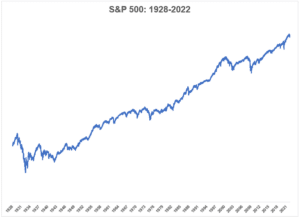If you’re looking for a reason to invest your money in the stock market, this graph offers a pretty compelling case:

Since 1928, the U.S. stock market is up 9.8% per year, including this year’s decline. In other words, a single investment of $10,000 in 1928 would have grown to $66 million today.
The stock market has posted positive returns roughly three out of every four years and there has never been a negative 20-year period on a nominal basis.
Historically, the long-term trend of the stock market has been up and to the right.

But why does this happen? Why do stocks generally go up over time?
Well, the answer is fairly simple. The biggest reason the stock market goes up over time is because the economy grows and companies earn more money.
Let’s look at the largest stock in the market, Apple, as an example. In the year 2014, Apple had sales totaling $182 billion with a profit of $39.5 billion. In 2021, just 7 years later, Apple’s revenue was $386 billion and the company produced profits of $94.7 billion. Sales more than doubled and profit increased 140%.

The entire market value of the U.S. stock market in 1982 was $1.2 trillion. Apple alone is now worth more than $2.5 trillion. The stock market goes up because businesses get bigger and earn more money over time.
If you own stocks, you get to take part in that growth. You benefit from the profits, cash flows, innovation, and growth of corporations.
Another reason the stock market goes up over time is because it sometimes goes down in the short term. However, this is a feature of the stock market, not a bug. Short-term uncertainty is the price to pay for long-term investing success.
This is why the ability to think and act for the long term is a crucial investing skill.
The shorter your time frame the wider your range of returns will be. The longer you go out the less volatility there is in the range of results. Here’s a graphgraph to help visualize the volatility in market returns based on different holding periods:

I’ve seen studies that show the average holding period for individual investors is around one to three years. Then after that people get bored or want to chase performance or simply find something new to invest in.
While three years might seem like a long time when you’re living through it (the last three years have sure been eventful), it’s a relatively short period of time in investing terms. Here are the historical best and worst returns for each holding period:

You can still get crushed over a 3-year window. At 10 years you can still lose a little money. Returns, based on history, tend to stabilize and remain positive over 20 and 30 years.
The stock market has never been down over 20 and 30-year time frames. Could it happen? Of course. Nothing is guaranteed when it comes to investing. But do you really want to bet against human ingenuity, innovation, corporate growth, and the innate human desire for progress?
Over the long run, the stock market has been an incredible place to grow wealth for those who have the patience.
Someone once asked Warren Buffett why more people don’t copy his buy-and-hold, long-term investment strategy. His answer:
“Nobody wants to get rich slowly.”
Thanks for reading!

